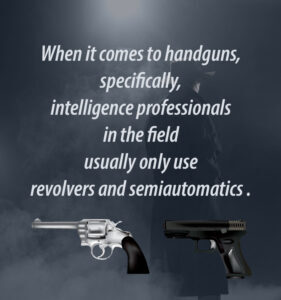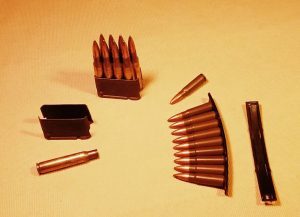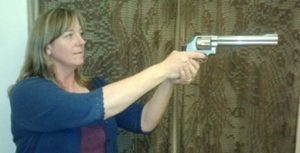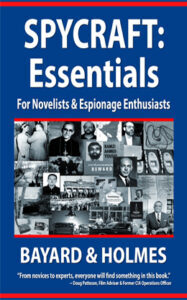Firearms: The Writer’s Guide to “Knowing Your Weapon!”

Firearms are a staple in many different genres of fiction. Choosing a genre is critical because it makes it far easier to define your audience, connect with them and ultimately, sell more books. Here is a post that explains all the different genres, as well as the nuanced differences.
Firearms are obviously most commonly used in thrillers, but they can be used in mystery, suspense and all the varied kissing cousin genres. For those who want to learn more, I have a class next week The Edge: How to Write Mystery, Suspense & Thriller where I will also cover more on this topic (register HERE).
Today, however, we’ll defer to the serious experts. Piper is here on behalf of the fabulous Bayard & Holmes to download some critical information.
Take it away, Piper!
Know Your FirearmWhether you love firearms, hate them, or can take them or leave them, they are a staple of crime and thriller fiction. Unfortunately, fiction is often laden with firearms fictions. Bayard & Holmes are dedicated to helping authors avoid those firearms fictions, so we’ll take a look at the firearms that turn up most often in espionage and crime fiction—the revolver, the semi-automatic, and the automatic.

Before we get to the differences in those types of handguns, though, we need to address the most common firearm misnomer of all time — the “clip” vs. the “magazine.” Time and again in fiction, shooters are reloading their “clips” into their “automatic” pistols, when they should be loading their “magazines” into their “semiautomatics.” Let’s take a look at the distinctions so that you savvy folks will never make those mistakes.
Clip Vs. MagazineA magazine has a spring that force-feeds the ammunition as the shooter fires. A clip does not have a spring or a feed mechanism. It simply holds the ammo and attaches to a magazine or inserts directly into a firearm. These are examples of “clips.”
 Image by Piper Bayard
Image by Piper BayardOn the left half of the picture, we have an empty M1 Garand clip, an M1 Garand clip loaded with eight rounds of 30-06 ammunition, and the brass from a 30-06 spent cartridge. On the right half of the picture, we have nine rounds of 7.62×39 ammunition loaded onto a “stripper clip” and an empty stripper clip. This stripper clip holds ten rounds. The tenth 7.26×39 cartridge is just above the loaded clip.
The clips are plain metal with no springs or gadgets of any kind that assist in feeding the ammunition through the firearm. Once the cartridges have been fired, the clips can be reloaded. However, in combat that is highly unlikely. A clip would normally be discarded and a new clip loaded into the magazine or the magazine well, depending on the firearm.
The vast majority of firearms made after WWII do not use clips.Extremely few modern weapons that use clips are being manufactured today unless they are replicas of old weapons, with the rare exception of a few Smith & Wesson revolvers that use moon clips. So unless your character is using a historical weapon or one of the rare modern firearms that take actual “clips,” the terminology is a fiction.
Next we have “magazines.” Magazines are widely used in both handguns and rifles. They can be detachable or not. They hold cartridges and can be quickly and easily reloaded. There are springs in the magazines that assist in feeding the ammunition through the firearms.
 Image by Piper Bayard
Image by Piper BayardThe larger magazine in the picture is an “extended grip” 9mm SIG Sauer magazine, and the smaller magazine is from a Smith & Wesson Bodyguard .380. These magazines fit into the handles of the pistols shown. Magazines are made of metal or plastic and can be reused countless times. They don’t get “used up” just because all of the rounds are fired.
Writing Tip:If you’re writing historical fiction, you might, indeed, have a weapon that uses a clip. If you are writing anything post-WWII, your weapon, unless it is a revolver, will likely have a magazine. We recommend you do a bit of research on the specific model of weapon in your manuscript, including the year it was made.
RevolversA revolver is so called because the cartridges reside in a revolving cylinder.
Almost no revolver ever made has an actual manual safety mechanism. Like the semiautomatic, one trigger pull equals one shot. However, the brass shells are not ejected automatically. A shooter must open the cylinder and eject all of the shells simultaneously and reload. A shooter can hasten this process by using a “speed loader” to insert all of the cartridges with one motion. The legalities of revolver ownership vary from state to state, but revolvers are generally the most legally accepted of handguns.
 Piper with Holmes’s .44 Magnum revolver, posing for the remake of Dirty HarrietThings to remember about revolvers:Ammunition is loaded into a cylinder.Revolvers virtually never have manual safety mechanisms.One trigger pull results in one shot.No brass is ejected.Legal in varying degrees according to state law. Semiautomatics
Piper with Holmes’s .44 Magnum revolver, posing for the remake of Dirty HarrietThings to remember about revolvers:Ammunition is loaded into a cylinder.Revolvers virtually never have manual safety mechanisms.One trigger pull results in one shot.No brass is ejected.Legal in varying degrees according to state law. SemiautomaticsWith a semiautomatic, ammunition loads into a removable magazine that usually fits into the pistol grip, like the ones pictured above.
To reload, a shooter drops the empty magazine out of the grip and snaps in a full magazine. Most people are able to drop a magazine and snap a new one into a semiautomatic faster than they can reload a revolver; however, a skilled shooter is just as quick with a speed loader. Like the revolver, one trigger pull always equals one shot. Unlike the revolver, the brass is ejected with each shot. Also unlike the revolver, a semiautomatic often has a manual safety device.
Semiautomatics are legal in all states, but only to varying degrees in different places. In a few states, they practically come as prizes in the bottom of Cracker Jack boxes, while in others, they are more difficult to obtain than a straight answer from a politician.
It is extremely common for a semiautomatic to be inaccurately referred to throughout media, movies, and TV as an “automatic” weapon. No matter how hot the journalist, movie star, or soap opera star might be, it simply isn’t so. If you make that mistake in your own writing, you are sure to get a bursting inbox full of corrections.
Things to remember about semiautomatics:Ammunition is loaded in a magazine.One trigger pull equals one shot.Often has manual safety mechanism.Brass is ejected, usually to the right of the weapon, every time a shot goes off.Legality varies according to state. Some states make semiautomatics difficult to obtain, or they restrict the size of the magazine. Other states have the Cracker Jack Box standard. AutomaticsWith an automatic weapon, the cartridges load into a removable magazine. The weapon is called automatic because when a shooter pulls the trigger, it automatically fires repeated bullets until the shooter takes their finger off the trigger. When the shooter fires, the brass shells of the cartridges are ejected from the weapon at high speed.
 Gunner’s Mate 1st Class Montrell Dorsey with
Gunner’s Mate 1st Class Montrell Dorsey withM240B automatic weapon
Image by US Navy, public domain
Modern automatic weapons are generally illegal for private ownership without special government procedures—emphasis on “generally.” There are three ways an individual in America can obtain an automatic weapon. . . .
The Firearm Owners Protection Act of 1986 made it illegal for private individuals to acquire fully automatic weapons without special permission from the Bureau of Alcohol, Tobacco, and Firearms. Private gun owners can still obtain one of the pre-1986 fully automatic firearms if they fill out a form, wait several months, secure a tax stamp, and purchase the firearm for an exorbitant amount of money—exorbitant because, according to the National Rifle Association, there are only around 150,000 pre-1986 fully automatic weapons in private ownership.
The second way private individuals can obtain an automatic weapon is by going through the intense process of obtaining a license to manufacture Class III/NFA firearms. Once the individual has this license, they can secure a conversion kit to modify a semiautomatic rifle to make it fully automatic. With the hassle and expense, though, we recommend using the money for a nice beach vacation rather than pursuing one of these weapons.
The third way to obtain an automatic weapon in America is the timeless and ever-popular method known as theft. If your characters try this method, especially with anyone who owns an automatic weapon, that owner might remember to use it on your character.
Things to remember about automatics:Ammunition is loaded in a magazine.One trigger pull equals multiple shots.Likely has a safety mechanism.Brass is ejected as the shooter is firing.Illegal for private owners everywhere in the United States except with a very detailed, expensive process.Other FactorsIt’s worth noting that different types of ammunition and barrels impact accuracy and are used for different purposes.
For example, Bayard & Holmes use hollow point cartridges for self-defense because the bullets are less likely to pass through the target and harm someone behind them. Different barrels with different types of rifling are also used depending on the purpose at hand.
Firearms experts have written treatises about the many subtleties of ammunition and barrels. If you discuss types of ammunition and barrels in your fiction, we recommend you read one of these treatises before you commit your writing to stone or Kindle. If you make a mistake, firearms experts will call you on it, and they can be pretty rough about it.
Writing Tip:Be aware that no matter how much you research, there are firearms aficionados who will write to you about the rarest and most obscure exception to whatever you say and tell you that you’re stupid. Don’t let that bother you. It’s what they live for. Be reasonably diligent in your vocabulary, hit the big things like “revolver,” “semiautomatic,” “automatic,” “clip,” and “magazine,” and you can be pretty sure the vast majority of your readers will be satisfied. As for the rest, don’t feed the trolls.
Thank You, Piper!I love these action-packed genres and I’ve lost count how many times I’ve encountered otherwise great books that botched their gun research. One time, I tossed a book across the room when the character put the safety on her revolver *silent screams*.
If we are going to put anything in our books, firearms included, then we need to do at least the basic research…which is why I have posts like this to help!
We LOVE Hearing From You!Any thoughts or questions? Piper is here to help y’all out so ask away.
Do your characters carry or use firearms? Which firearms do they use? What are your firearms pet peeves in fiction? Do you have any questions for us? SALE!
LIMITED TIME ONLY $2.99 — Click Here
SALE!
LIMITED TIME ONLY $2.99 — Click Here
What do the main intelligence agencies do and where do they operate? How do they recruit personnel? What are real life honey pots and sleeper agents? What about truth serums and enhanced interrogations? And what are the most common foibles of popular spy fiction?
With the voice of over forty years of experience in the Intelligence Community, Bayard & Holmes answer these questions and share information on espionage history, firearms of spycraft, tradecraft techniques, and the personalities and personal challenges of the men and women behind the myths.
Though crafted with advice and specific tips for writers, SPYCRAFT: Essentials is for anyone who wants to learn more about the inner workings of the Shadow World.
“For any author, this is the new bible for crafting stories of espionage.”~ James Rollins, New York Times Bestselling Author of The Demon Crown
Piper Bayard and Jay Holmes of Bayard & Holmes are the authors of espionage tomes and international spy thrillers. Please visit Piper and Jay at their site, BayardandHolmes.com. For notices of their upcoming releases, subscribe to the Bayard & Holmes Covert Briefing. You can also contact Bayard & Holmes at their Contact page, on Twitter at @piperbayard, on Facebook at Piper Bayard, or at their email, BayardandHolmes@protonmail.com.
CLASSES!TONIGHT! Introduction to Podcasting 10/15/21Register HERE
Writing for Podcasting 10/22/21Register HERE and use New20 for $20 off before October 15th
How to Make MONEY & The Business of Podcasting 10/26/12Register HERE and use New20 for $20 off before October 15th
The Pod People Podcasting Bundle: ALL THREE Classes ONE Low PriceRegister HERE to get all three classes and save BIG!
Practice Your Pitch: Master the Log-Line 10/20/21Register HERE and use Pitch10 for $10 off if register by 10/1/21
The Edge: How to Write Mystery, Suspense & Thriller 10/21/21Register HERE and use Thrill10 for $10 off if you register by 10/14/21
The post Firearms: The Writer’s Guide to “Knowing Your Weapon!” appeared first on Kristen Lamb.



